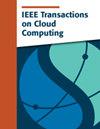VSA-SD: A Service Discovery Method Based on Vector Symbol Architecture for Low-Cost IoT System Development
IF 5
2区 计算机科学
Q1 COMPUTER SCIENCE, INFORMATION SYSTEMS
引用次数: 0
Abstract
In recent years, with the widening applications of the Internet of Things (IoT), more and more perception services (e.g., air quality indicator services, road traffic congestion monitoring services, etc) with different arguments (e.g., data type, source location, creator, etc) will be deployed by dedicated IT infrastructure service providers for constructing customized IoT systems with low cost by subscription. So it is an indispensable step to check whether the required perception services with specified arguments have been available for the constructing IoT through discovery method to reduce the redundancy of service deployment. However, it is a challenging problem to design efficient (i.e., achieving high accuracy and low response delay with low overhead), highly robust, and trustworthy mechanisms for discovering perception services on resource-constrained IoT devices. To solve this problem, we proposed a distributed service discovery method, named VSA-SD, based on the Vector Symbolic Architecture (VSA). This method employs hyperdimensional vectors to describe services in a distributed manner, and measures the degree of service matching by calculating the Hamming distance, thereby achieving service discovery. We implemented VSA-SD in NBUFlow, which is an IoT task construction and offloading test platform, and evaluated its performance through comprehensive experiments. Results show that VSA-SD outperforms the centralized, hybrid, and other distributed service discovery mechanisms in terms of accuracy, response delay, overhead, robustness, trustability, interoperability, and mobility.VSA-SD:基于矢量符号架构的服务发现方法,适用于低成本物联网系统开发
近年来,随着物联网(IoT)应用领域的不断扩大,越来越多的感知服务(如空气质量指标服务、道路交通拥堵监测服务等)将由专门的 IT 基础设施服务提供商部署,这些服务具有不同的参数(如数据类型、来源位置、创建者等),通过订阅的方式以低成本构建定制化的物联网系统。因此,通过发现方法检查是否已为构建物联网提供了所需的具有指定参数的感知服务,以减少服务部署的冗余,是一个不可或缺的步骤。然而,如何在资源受限的物联网设备上设计高效(即实现高准确性、低响应延迟和低开销)、高鲁棒性和可信的感知服务发现机制是一个具有挑战性的问题。为了解决这个问题,我们提出了一种基于矢量符号架构(VSA)的分布式服务发现方法,命名为 VSA-SD。该方法采用超维向量以分布式方式描述服务,并通过计算汉明距离来衡量服务匹配程度,从而实现服务发现。我们在物联网任务构建与卸载测试平台NBUFlow中实现了VSA-SD,并通过综合实验评估了其性能。结果表明,VSA-SD 在准确性、响应延迟、开销、鲁棒性、可信任度、互操作性和移动性等方面都优于集中式、混合式和其他分布式服务发现机制。
本文章由计算机程序翻译,如有差异,请以英文原文为准。
求助全文
约1分钟内获得全文
求助全文
来源期刊

IEEE Transactions on Cloud Computing
Computer Science-Software
CiteScore
9.40
自引率
6.20%
发文量
167
期刊介绍:
The IEEE Transactions on Cloud Computing (TCC) is dedicated to the multidisciplinary field of cloud computing. It is committed to the publication of articles that present innovative research ideas, application results, and case studies in cloud computing, focusing on key technical issues related to theory, algorithms, systems, applications, and performance.
 求助内容:
求助内容: 应助结果提醒方式:
应助结果提醒方式:


